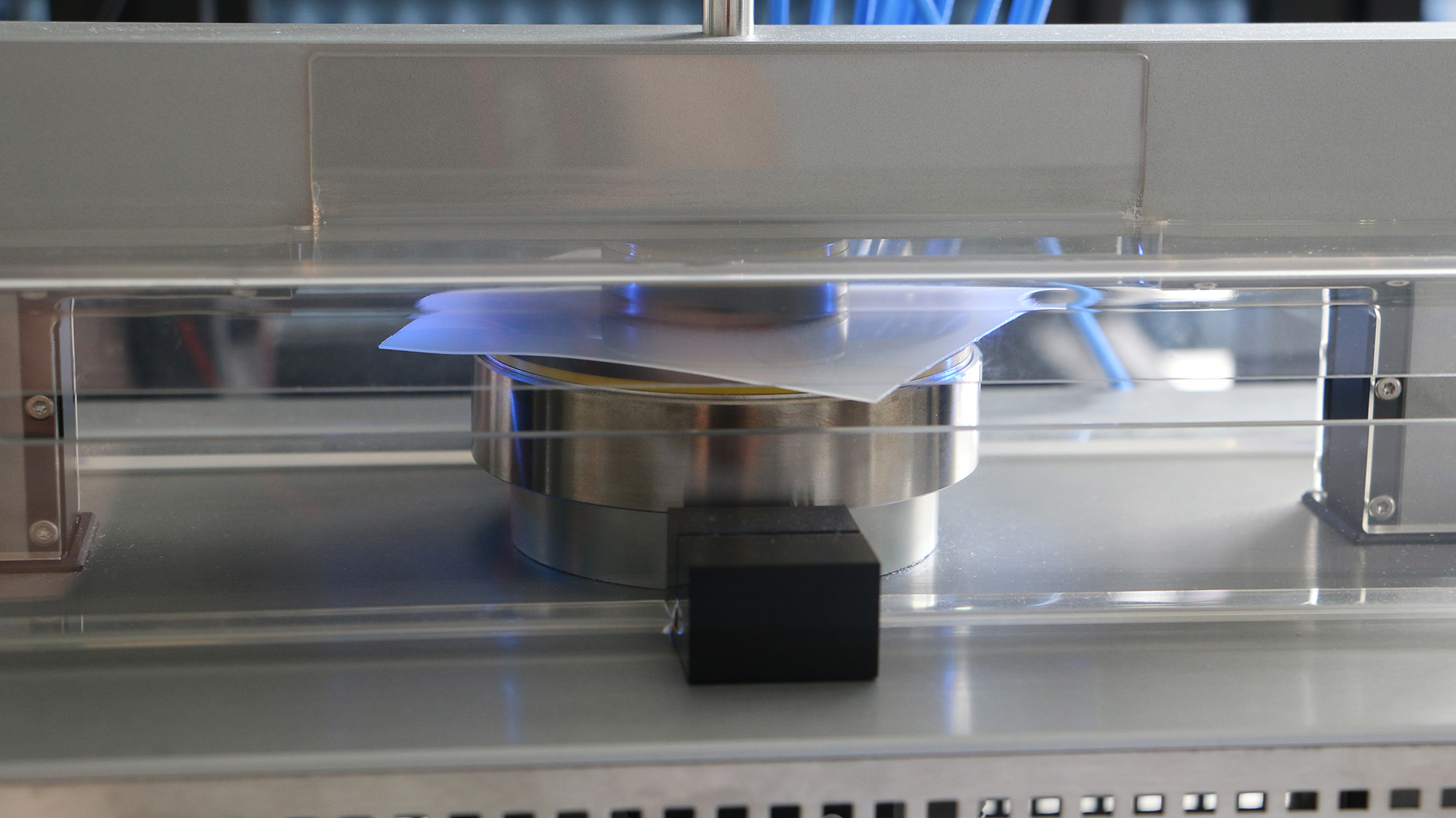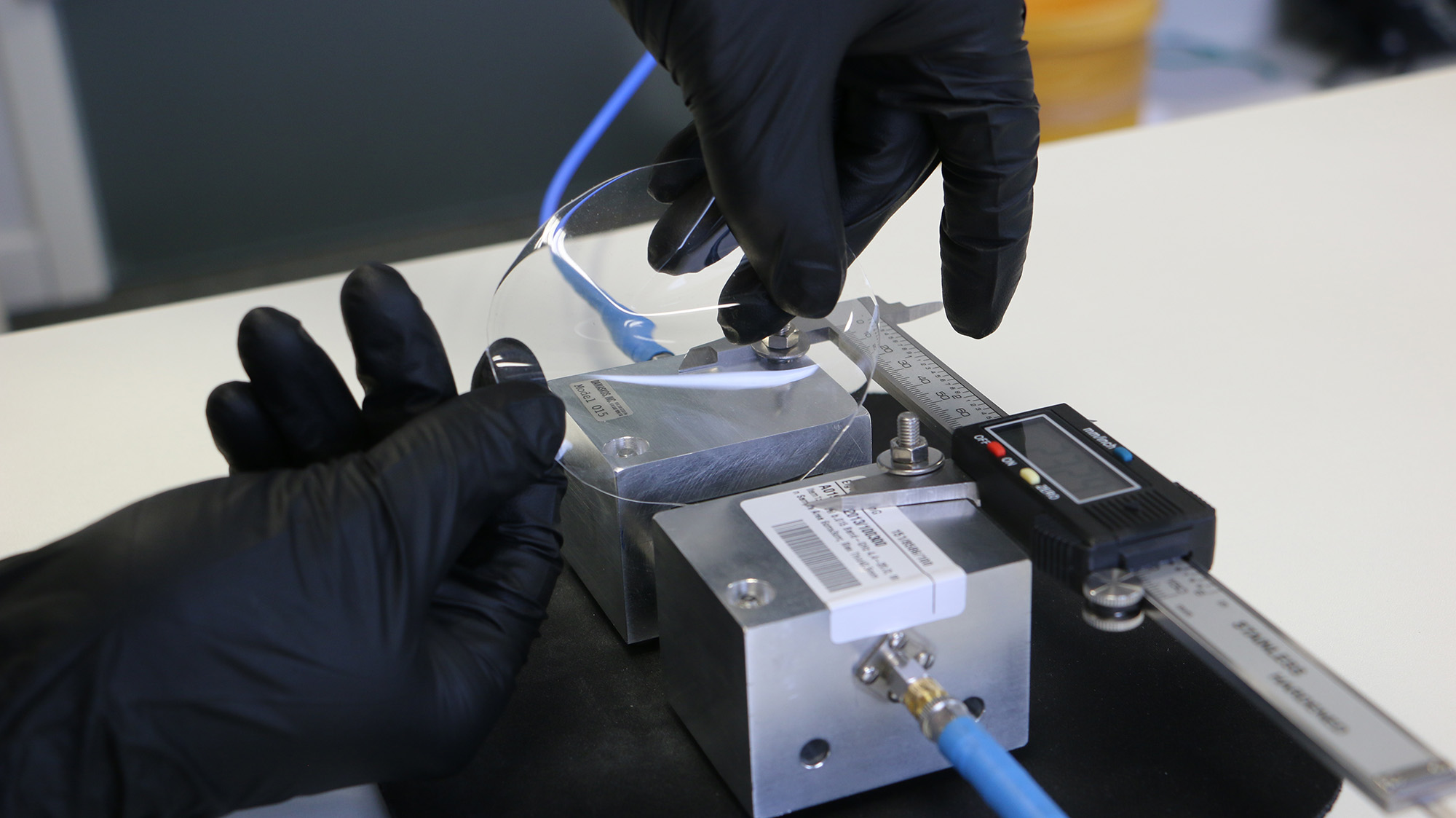Metasurface antennas
Intelligent skin for more precise communication and near-field sensing in robotics
Specific physical human-robot interactions are increasingly required in the manufacturing industry, the professional service sector, and healthcare. This necessitates improvements in comfort and convenience as well as in communication between humans and machines. Robots need to be able to predict human actions and recognize intentions. And that calls for flexible metamaterials, and more specifically, flat metasurface antennas with highly integrated electronics that allow for sensing of the near environment. The Fraunhofer Institute for High Frequency Physics and Radar Techniques FHR has teamed up with six partners in the EU’s FITNESS project to develop these kinds of surfaces, which cover a robot like an adaptive, intelligent skin. The idea is that robots equipped with metasurface antennas will be able to scan their near-field environment with greater accuracy and communicate more effectively with their base station in the far field.
Robots are playing an increasingly important role in industrial manufacturing in particular. In line with this trend, physical interactions between humans and robots have become a key technology helping to make production processes more efficient.
When developing human-machine interactions, worker safety is paramount. This is where the EU’s FITNESS (Flexible IntelligenT NEarfield Sensing Skins) project comes in. The project aims to optimize communication and interaction between humans and machines through intelligent antenna solutions in the form of innovative electromagnetic metamaterial surfaces with integrated electronics. The flexible, stretchable metasurface antenna, which are suitable for emitting surface waves, are expected to scan their near-field surroundings much more effectively than conventional antennas, thereby improving both human safety and the robots’ own performance. Six other partners from industry and the research sector are working on the project with Fraunhofer FHR: the French National Centre for Scientific Research (CNRS), eV-Technologies, Hamburg Uni-versity of Technology (TUHH), Université catholique de Louvain (UCLouvain), University of Zagreb Faculty of Electrical Engineering and Computing, and L-up. The project is being coordinated by UCLouvain, in Belgium, and is being funded by the European Union under GA No. 101098996.
Intelligent antenna skin with sensory and communicative functions
The metasurface antennas are flat antennas integrated into filmlike substrates that adapt to the robot’s contours. Thanks to their flat structure, these antennas can bend and stretch, wrapping around the robot like a skin. Alternatively, and depending on the application, they can also be positioned only on the robot arm, for example. That is how they came to be called “smart skins.” “What makes our future antenna solution special is that it can scan the near-field environment and detect movement while also being proficient at radio-based communication with the base station on the shop floor,” says Andrej Konforta, 3D-Print HF Systems group manager at Fraunhofer FHR. “No other solution like it exists on the market so far.”
Small geometries, high degree of freedom
The researchers’ goal is for the novel, innovative antenna solution to enable beamforming, a process used to control the radiation properties of an antenna electronically. The result is that the adjustable electromagnetic beam always faces toward the base station, guaranteeing a stronger, more stable signal and increasing the robot’s range. So far, beamforming has been typically supported by what are known as “phased arrays.” “In a phased array, many antennas are connected as a group. The phase of each individual antenna element is variable, which makes it possible to affect the direction the array is facing,” Konforta explains. The technology has previously been used mainly in military contexts. In conventional antenna arrays, the antenna elements and their electronics are packed close together. This produces high costs, a lot of waste heat, and high susceptibility to errors. Metasurface antennas, on the other hand, could be designed with significantly streamlined electronics — without losing the properties of the conventional configuration. The new concept can help to cut costs and realize smaller, more compact structures. “With the metamaterial surfaces, we’re pursuing a new design concept that allows for very small geometries with a high degree of freedom in the design of the fields emitted but also for the best possible extraction of gesture signals,” Konforta says.
Developing new antenna substrates
Antennas are typically integrated into rigid microwave substrates. There are also materials that can stretch, thus offering a high degree of flexibility. However, losses are too high with these flexible substrates: They do not perform optimally in the high-frequency range, as the measurement technology developed by the Fraunhofer FHR researchers showed. This means the conventional substrates available on the market are not an optimum fit for transmission of high-frequency signals. Based on Fraunhofer FHR’s findings, TUHH is developing new substrates as part of the FITNESS project. The Institute of Applied Polymer Physics (IAPP) is using a polymer mix and polymers with integrated ceramic particles to synthesize stretchable materials that are potentially suitable for high frequencies. These materials will then be tested by Fraunhofer FHR as the project moves forward. An existing measurement setup is also being optimized based on initial results and expanded for other frequency bands while the software for the fi-nal setup is being developed as well. At the same time, the project partners are investi-gating how deformations in the stretchable surfaces affect their properties in the near and far fields. Long-term plans call for self-calibrating metasurface antennas that autonomously recognize their curvature and shape to ensure optimum signal reception and prevent communication issues.
A whole host of applications
In addition to robotics in production settings, the project partners also believe medical engineering and robotics are potential fields of application. Metasurface antennas in smart skin form could help devices such as assistance robots recognize gestures more accurately and interact more with humans. There are also potential uses for this technology in personal protective equipment for firefighting and in space suits.

